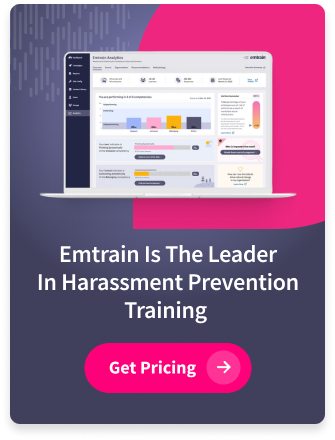“Hey everyone! It’s time for your MANDATORY harassment training!”
When your employees and managers hear this chant, well, they want to run for cover. As someone who has delivered this type of training for the past 20 years, there are some things employers and trainers can do to provide training that is impactful, meaningful, and that can help support or shift culture.
1. Positive and Encouraging Messaging
How you announce and get people interested in the training starts at the beginning. Think of a good title for the training beyond “Harassment Prevention Training.”
You need to know the goals of your training and how to spread the word. Consider addressing several “why” questions:
- Why is harassment training important on an individual level?
- Why is harassment training important for your workplace?
- Why do we need to do harassment training again?
Have a flyer that might pique their interest, such as:
“I always hug my employees…we’re like family! Is that ok?”
“I overheard an employee telling a group of co-workers a joke about immigrants. Everyone laughed, so I didn’t say anything.
Did I do the right thing?”
“No one wants to work with the guy who made a harassment complaint.
I tell everyone they don’t have to.
Is that the right answer?”
In your messaging, highlight that the training is meant to:
- Educate for common understanding
- Get people to think differently
- Impact culture
Craft the message to be short and to the point. If you tend to default the fact that the training “is mandatory under the law,” don’t be surprised if your employees want to avoid the training or take a snooze. If you have core values – highlight that the training will reinforce those values. Educate your organization on how frequent laws change and that the company wants to make sure everyone is up-to-date on the employers’ and managers’ obligations as well as everyone’s rights in the workplace.
2. Leadership Buy-In and Ownership
One of my colleagues had an experience where the CEO introduced her to the attendees and made a reference that he was not looking forward to the training, but he would give the trainer a chance. Unbelievable. Talk about killing culture and undermining the importance of the training.
Buy-in from leadership is critical. Leaders must have some ownership of the messaging and the training. Provide talking points to leaders about the importance of the training, culture, goals and that inappropriate conduct won’t be tolerated. Reinforce that leaders are the role models for positive culture and appropriate workplace behavior. When your company leaders take the training seriously, talk about the importance of the training – and show-up engaged, it’s a win-win situation.
3. Interactive Content
Ditch the PowerPoint presentations! Instead, consider:
Engaging Delivery
- Discussion-based training!
- Storytelling
- What ifs…
- What would you do or say?
- Appropriately adding humor
Relevant Content
- Use provocative, relevant examples and scenarios relatable in your workplace
- Focus on respect/civility!
- Include topics on microaggressions, bystander, bullying, and power dynamics (actual or perceived)
- Where is the line in your workplace?
- Modify content for each level – executive, manager, supervisor, and non-manager
- Be mindful of the word choices beyond harassment
- Inappropriate, disrespectful, unacceptable
Actionable Takeaways
- Create scripts. Help employees and management with respectful language to use to call out inappropriate conduct. No one wants to be “that person” – the one who highlights bad behavior, but many people want to say something, they just don’t know what to say. Help them with takeaways they can use right after the training is over.
- Highlight culture – often. Things won’t change if inappropriate conduct isn’t called out privately or gently in public. Consistently reinforce the message that everyone is responsible for creating a respectful work environment.
- Anti-retaliation. Emphasize that everyone is entitled to make a complaint. Period. Describe what is – and isn’t – retaliation.
- Keep the dialogue going. Encourage leaders, managers, and employees to continue talking about harassment prevention, respect and related issues. Don’t wait every two years to talk about gender, race and other delicate issues. But, it’s imperative to give your workforce mini-topics and some guide questions to lead informal discussions. For example, asking people if they know what a microaggression is and providing examples. In your company lunch ‘n learns, town hall meetings or in team meetings, hold a “mini” teachable moment about prevention practices and equality in your workplace.
The key here is to make your harassment prevention training as engaging and relatable as possible. By just giving your employees online training once a year isn’t enough. So, consider continuing the conversation to make a stronger, more positive impact in your workplace.










